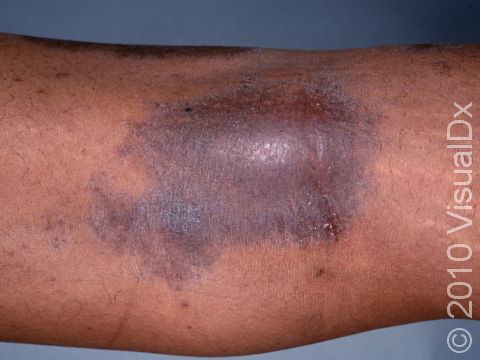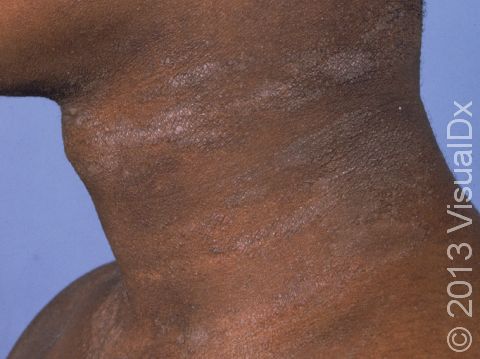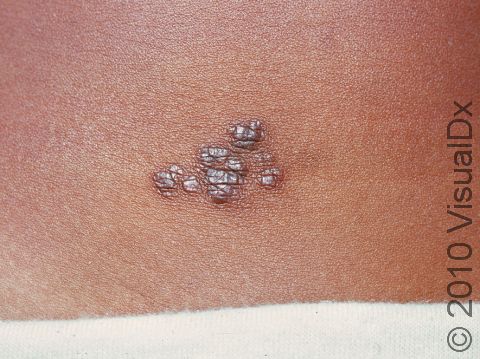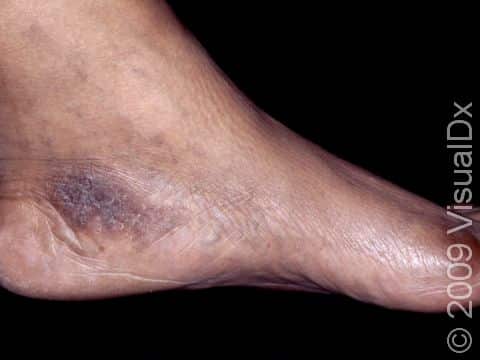Lichen Simplex Chronicus
Lichen simplex chronicus is an itchy skin condition causing thickened skin at areas that have been injured by repeated scratching and rubbing.
Lichen simplex chronicus is not a primary disease but rather the skin’s response to chronic physical injury / trauma. This gradual thickening of skin is called lichenification.
Lichen simplex chronicus begins as itchy skin. The itching leads to scratching and rubbing, which causes thickening of skin. Thickened skin is itchy, which causes more scratching and, thus, more skin thickening. This scratch-itch cycle then continues if it is not treated.
Who's At Risk?
Lichen simplex chronicus can occur in people of any age, race / ethnicity, or sex. However, it is more common in females. Although it is rarer in this population, lichen simplex chronicus can occur in children. It appears most frequently in middle-aged and older adults.
Conditions that can lead to a scratch-itch cycle that may cause lichen simplex chronicus include:
- Insect bites.
- Scars.
- Eczema (atopic dermatitis).
- Dry skin (xerosis).
- Anxiety and stress.
Signs & Symptoms
Lichen simplex chronicus can occur anywhere on the body that the person can reach. Each plaque (a slightly raised area of skin larger than a thumbnail) of lichen simplex chronicus appears as leathery, thickened skin in which the normal skin lines are exaggerated. The thickened skin is darker than surrounding skin (hyperpigmented). In lighter skin colors, the lesions are often pink, red, or purple, and in darker skin colors, they are often brown, purple, or grayish. This hyperpigmentation is especially apparent in darker skin colors.
Individuals with lichen simplex chronicus report periodic itching that is most intense at night and at other times when they are quiet and not active.
Self-Care Guidelines
The primary treatment is to stop scratching. However, this can be very difficult once a scratch-itch cycle has started. You may need to cover areas of lichen simplex chronicus at night to keep your child from scratching them during sleep.
Use moisturizers to help relieve itchy skin. When choosing a moisturizer for your child, look for oil-based creams and ointments (eg, CeraVe Healing Ointment, CeraVe Moisturizing Cream), which work better than water-based lotions. Apply moisturizers just after bathing the child, while the skin is still moist.
Apply over-the-counter hydrocortisone cream (eg, Cortizone-10) or give your child an antihistamine (eg, cetirizine [Zyrtec] or diphenhydramine [Benadryl]) to reduce the itch. Note that if the itching is limited to the groin area, your child may have a fungal infection (tinea cruris, or jock itch) rather than lichen simplex chronicus; do not apply hydrocortisone to the groin area unless recommended by a medical professional.
If there are breaks or cracks in your child’s skin, apply an antibiotic ointment (eg, Neosporin, Polysporin) to prevent infection.
Treatments
The medical professional will look for an underlying cause of the itch and will advise on how to break the scratch-itch cycle. In addition to the above self-care measures, your child’s medical professional may recommend one or more of the following treatments to reduce itching and scratching:
- Prescription corticosteroid (cortisone) creams or ointments
- Prescription oral antihistamines, especially for use at bedtime
- Injection of corticosteroid solution directly into the lichen simplex chronicus lesions
- Ultraviolet light therapy if the lichen simplex chronicus is widespread
- Topical or oral antibiotics if infection is present
- Consultation with a mental health professional if underlying anxiety or stress is driving the rubbing / itching behavior
Visit Urgency
See your child’s medical professional if the itching does not improve with self-care measures, if more lesions are appearing, or if your child develops symptoms of infection such as pain, redness, drainage of pus, or fever.
References
Bolognia J, Schaffer JV, Cerroni L. Dermatology. 4th ed. Philadelphia, PA: Elsevier; 2018.
James WD, Elston D, Treat JR, Rosenbach MA. Andrew’s Diseases of the Skin. 13th ed. Philadelphia, PA: Elsevier; 2019.
Kang S, Amagai M, Bruckner AL, et al. Fitzpatrick’s Dermatology. 9th ed. New York, NY: McGraw-Hill Education; 2019.
Paller A, Mancini A. Paller and Mancini: Hurwitz Clinical Pediatric Dermatology. 6th ed. St. Louis, MO: Elsevier; 2022.
Last modified on June 18th, 2024 at 8:12 am

Not sure what to look for?
Try our new Rash and Skin Condition Finder



